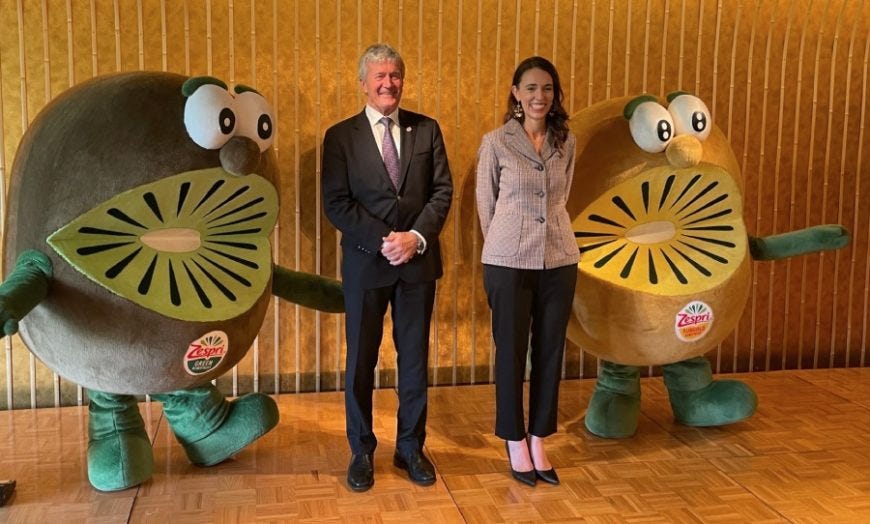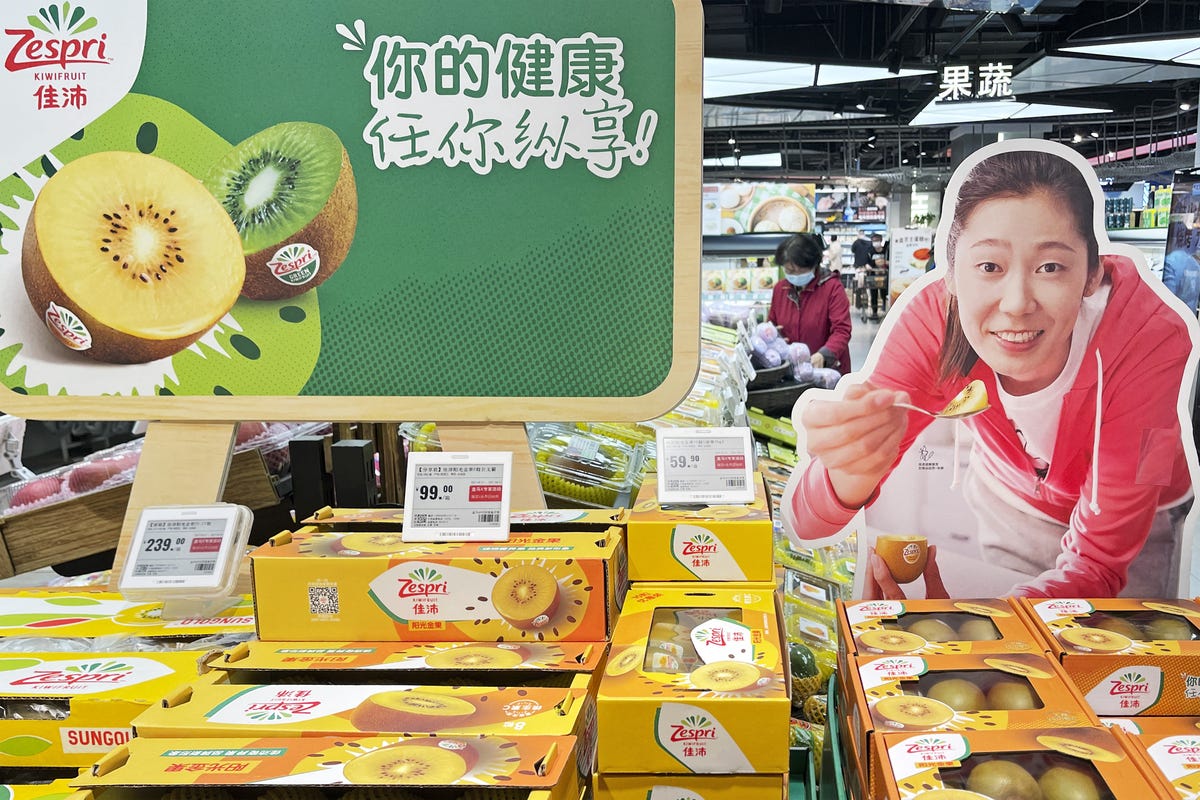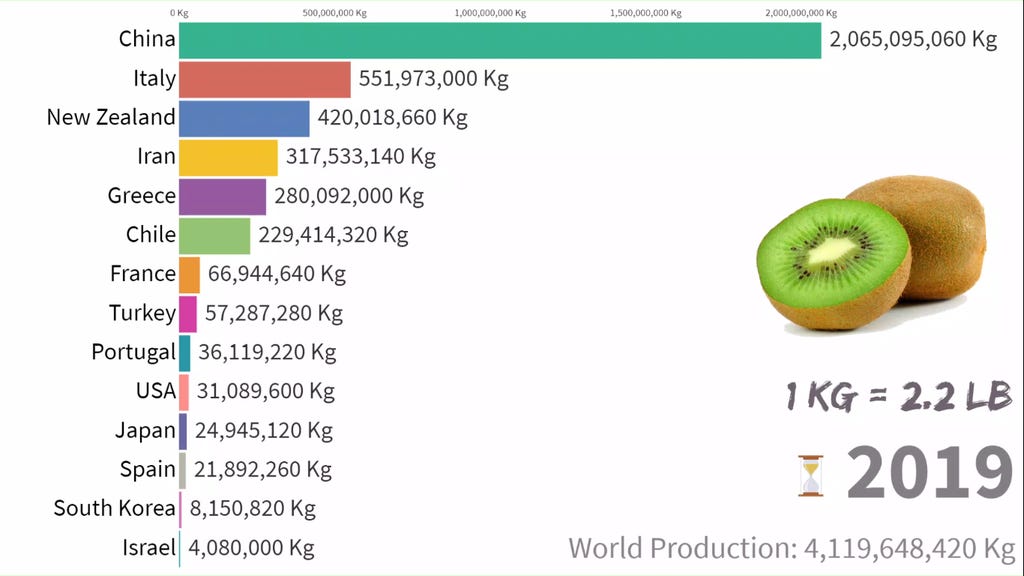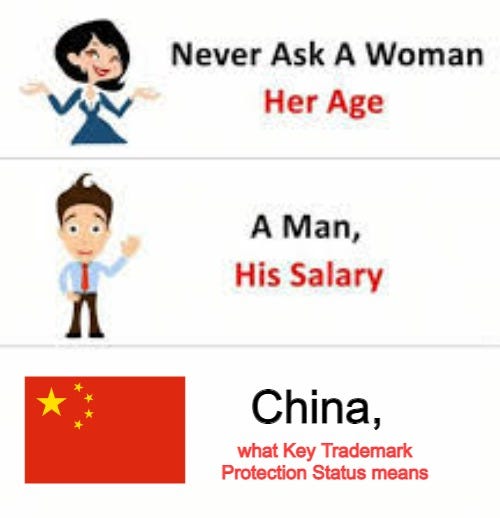A tale of theft and then balancing both commercial and political risk amidst the fallout, along with the complexities of doing business with China. The story of the SunGold Kiwifruit can be a cautionary one, and I’ll explain why.
Wanna watch this post instead? Check it out on YouTube:
Prized Kiwifruit cuttings were smuggled from New Zealand into China, and no one knows what to do about it.
Kiwifruit, AKA Chinese Gooseberries, are native to central and eastern China, but it was New Zealand that perfected the SunGold variety popular on supermarket shelves today.
Yet one bloke, a kiwi thief if you will, is accused of smuggling cuttings of the prized SunGold variety to China's Sichuan province, enabling local farmers to cultivate several orchards of counterfeit plants. These illegal kiwifruit orchards are spreading far and wide across China, like wildfire, but imagine if wildfire created trees instead of destroying them.
But how New Zealand deals with this situation isn’t so straightforward. This story of the stolen SunGold kiwifruit is about balancing both commercial and political risk, and the complexities of doing business with China. The time is ripe for a deep dive like this, and I intend to take advantage of all the low-hanging fruit puns available to me. So let’s get stuck in.
Background of the kiwi
Kiwifruit is big business for Australia’s little brother. The humble fruit is New Zealand’s largest fresh fruit export, valued at $2.3 billion in 2019 and a whopping 545,800 tonnes of kiwifruit exports were sent overseas, with two-thirds of that going to Asian countries.
New Zealand even has a kiwifruit regulator that makes decisions on all national issues relating to the little furry fruit.1
But let me introduce Zespri. Zespri Zespri is the co-operative that owns the SunGold brand and the body that sells farmers the licence to grow it. They are the world’s largest marketer of kiwifruit, selling to more than 59 countries and managing 30% of the global volume. China is their largest market, buying more than 100,000 tons of kiwis from the company every year and accounting for more than 20% of its global sales. But not all kiwifruit is like the others!
The Kiwi that laid a golden egg
This is the SunGold kiwifruit. Compared to its green friend, it has a bright yellow inside, a tangy sweetness, smoother flesh and fewer seeds
And consumers don’t just love them, farmers do too. It has a stronger tolerance to a disease that devastated the previous variety of golden kiwifruits, and they grow prolifically meaning farmers get a really high yield off it as a crop, and it’s even easy to pack when shipping!
Zespri Group owns the rights to the SunGold kiwifruit, which it began cultivating in the 2010s. And since the SunGold variety is the property of Zespri, anyone who wants to grow it has to cough up over $500,000 for the license to plant one hectare of the fruit.
The payment is a one-off and the farmers also gain access to global supply chains and marketing campaigns.
To the surprise of no one, the SunGold variety has become the golden child of the New Zealand kiwifruit family, selling the most trays across the world and driving the $3.5 billion in global sales Zespri made last financial year.
Gold Rush
But while New Zealand producers continue to grow and profit from their sun gold kiwi fruits as they have for years, plantations of counterfeit SunGold kiwifruits are now bearing fruit all across China.
And whilst these vines produce the same golden variety of kiwifruits, they are not licensed or held to the same quality standards as those grown by Zespri farmers in New Zealand.
Zespri, realising the fruits of their labour being stolen, resolved to get to the root of the problem. Court documents tell the absurd story of how Zespri found out how their kiwifruits were being grown illegally in China.
Like anything you don’t want to hear, it started as a rumour.
In 2016, Zespri's China-based staff had heard their SunGold kiwi variety was being grown locally, so Zespri engaged private investigators and on their advice, contacted a grower in China, who openly admitted he was cultivating SunGold kiwifruit. He even welcomed Zespri staff onto his orchard to see for themselves! No, I am not making this up.
Eventually, they traced the source of illegal kiwis to Haoyu Gao, who had bought a kiwifruit orchard in Opotiki, a tiny town in New Zealand’s Bay of Plenty. According to court documents, he smuggled a precious cargo of buds to Sichuan, where he hawked female sprouts for NZ$60,000 a lot.
Zespri took their grievances to New Zealand's High Court, which found Gao had breached both NZ intellectual property law and his licence agreement with Zespri, and Gao was ordered to pay $15 million in damages.
The court result was a win on paper for Zespri, but did it really change anything?
David vs Goliath
In 2020 Zespri estimated there were around 5,400 hectares of unauthorised plantings in China, up from 2,500 hectares in 2019. For context, there are just over 8,000 hectares licensed in New Zealand. So the pressure is on Zespri on figuring something out so they don’t lose their livelihood.
China’s total kiwifruit industry currently extends over 250,000ha, meaning assuming unauthorised plantings are even enforced in the first place, it’s hard to even track in the first place.
China is already the world's largest kiwi producer with an annual output reaching over 2 million tons in 2018, according to the most recent government data. Overall, China accounts for 55% of global kiwi production, which is over 13 times that of New Zealand.
And not a producer, China is also one of the biggest consumers of Kiwis. In 2019, the country imported 123,000 tons, worth $436 million.
So this situation puts not only Zespri but also New Zealand in a delicate spot.
Zespri must work to defend its intellectual property and the value of its licence, but China is also one of Zespri's biggest buyers of the real deal SunGold kiwifruits.
In Beijing, the legitimate SunGold kiwifruit is popular. But Zespri believes counterfeit fruits are not being sold in tier one Chinese cities.
There was a proposal on the table that would see some of the Chinese growers brought under the Zespri tent, effectively licensing the fruit from the stolen plants.
Zespri thought the cooperation would be more effective in the long run, in terms of the fiscal health of the kiwifruit industry in New Zealand, rather than confrontation, litigation and other kinds of attempts to gain justice.
A Kiwi or a Kiwifruit Problem?
The value of New Zealand's trading relationship with China sits at about $19 billion a year and while kiwifruits make up only a small portion of that, analysts are quick to point out how exposed the small nation is to the Asian superpower.
The New Zealand government could make a larger issue out of this, but you only have to look at Australia for an example of what to expect if New Zealand were to criticise China too directly. the possibility of retribution is always there and the Chinese could easily do without New Zealand's imports.
Zespri’s solution? If you can’t beat ‘em, join ‘em (or at least buy ‘em). In 2020, Zespri proposed a bold deal to their growers: Rather than going after illegal Chinese orchards, they propose a year-long trial of buying up and marketing counterfeit kiwifruit grown in China under the Zespri brand.
Zespri wanted to use the trial to see if the Chinese-grown fruit could meet its quality standards and to test whether or not Chinese consumers would be willing to pay a premium for fruit without the "Product of New Zealand" sticker.
Zespri Growers were asked to vote on the proposal - with a threshold of 75 per cent grower support needed for Zespri to continue with a commercial trial.
But the results were 70.5% of growers supporting the primary resolution to carry out a one-year orchard monitoring, procurement and sales and marketing trial in China.
And only 64.1% supported the secondary resolution to use the Zespri brand label as part of the sales trial in order to understand consumer response. So what happens now? I’m about as confused as you are.
Securing the golden gooseberry
On the topic of kiwifruits, China and New Zealand, someone is bound to bring up this argument sooner or later.
Some people argue New Zealand stole the kiwifruit first, in the early 1900s, and that China has done nothing more than take back what is rightfully theirs.
But intellectual property law is there to protect those who invest in developing unique goods, which is what New Zealand has done with the SunGold variety of kiwifruit. But the law isn't always easy to enforce in the global marketplace.
In early 2020, Zespri announced it was the first New Zealand company and the only fruit brand to secure "Key Trademark Protection Status" in Shanghai. But that only protects Zespri’s branding, not the unique plants the fruit grows on. So "Key Trademark Protection Status" sounds a lot like “Doesn’t Do Diddly-Squat”.
The future of Zespri and their SunGold Kiwifruit is unclear. And there are a million different ways that this might play out. Zespri in their latest annual report gave some insight:
Our focus now is on continuing with our core business and gathering information to discuss possible next steps with growers. This will include continuing with our R&D, progressing our efforts to understand the local kiwifruit production environment and engaging further in China to better understand the unauthorised plantings, their potential impact and possible ways forward.
But to me, it sounds like they’re talking a lot, but aren't really saying anything.
Maybe the best thing Zespri can do to keep the New Zealand-China kiwifruit trade on track is to simply grow a product Chinese customers love.
If you’ve enjoyed this analysis from a half kiwi bastard born across the ditch (AKA me), you might like my post on the Gambling Scene in Australia. But until next time, have a good one!
You can find previous posts here. I also interview legends at Compounding Curiosity and lurk on Twitter @scarrottkalani.
Want to get in contact? Reply to this email, comment on Substack, or send a letter via carrier pigeon and trust that fate will deliver it.
Enjoyed this? Chuck a “❤️” on Substack or share it with a mate











Man where do you get the ideas for your content. This was such an interesting (and never thought about) story.